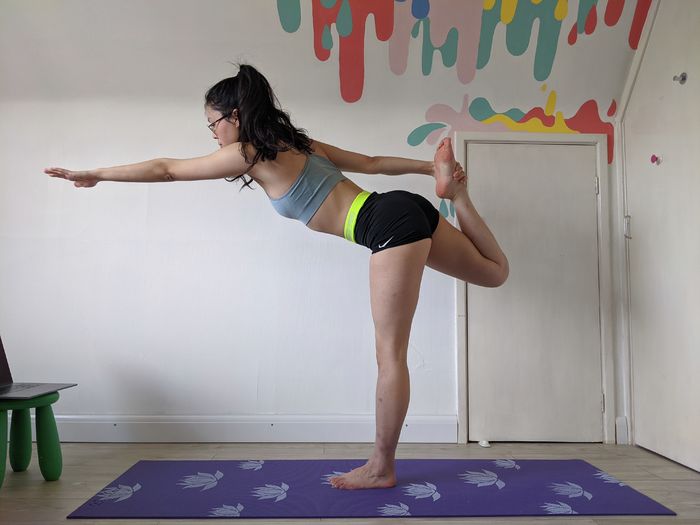Quaran-training: How to exercise in lockdown
Should you eat before exercise, or after? What about stretching? What kinds of exercise should you do? Abigail Burn answers these questions and more on lockdown exercising.

First it was the loo roll. Then it was the flour. Now there is a new pandemic-induced shortage… bikes. With time on our hands and energy to burn, this boom in bicycle sales is symbolic of many people’s eagerness to get outdoors or take up home exercise during lockdown. So, whether you’ve hopped on the bandwagon and downloaded Strava (kudos!), subscribed to Joe Wicks, or been out for a daily plod; this article addresses a few misconceptions to help you get the most out of your quaran-training!
Desperate to get the day off to a good start, it may seem like a good idea to follow the widely held belief that the best time to work out is first thing in the morning. Whilst a study published in Nature did find working out in the morning helped promote weight loss, really the best time to work out is at a time which allows you to exercise most consistently. There may be marginal benefits to exercising first thing in the morning, but any significant benefits will only manifest if your exercise routine is sustainable.
Before you launch into lunges, it is necessary to address the widely held misconception that stretching before exercise prevents injuries. Intuitively, stretching would seem to loosen the muscles and minimise the risk of injury. However, a study published in the journal Research in Sports Medicine concluded that static stretching is ineffective in reducing the incidence of exercise-induced injuries overall. This was particularly true for bone and joint injuries although the relationship between static stretching and the incidence of musculotendinous injuries was less conclusive.
Instead, doing a warm-up before exercise is of more benefit. In contrast to static stretching which is a passive technique, warm-ups and dynamic stretching actively increase muscle blood flow and temperature helping to increase muscle flexibility and reduce the risk of injury. Furthermore, a warmup is part of the ‘anticipatory phase’ of exercise which prepares you physiologically and psychologically for exercise.
“While it is feasible to exercise on an empty stomach, beyond personal preference there aren’t many benefits to doing so.”
On the subject of preparation, should you eat beforehand? Or hold off until after exercise? To answer this, it is important to understand the metabolic changes taking place during exercise. Initially, the body burns carbohydrates anaerobically because it takes a couple of minutes for the heart and lungs to increase oxygen delivery for aerobic metabolism. Then the body begins to burn a combination of fat and glycogen, the form in which glucose is stored. Proponents of exercising while “fasted” suggest doing so speeds up weight loss because with glycogen stores depleted, the body has to resort to burning fat. Indeed, a study published in the British Journal of Nutrition did find that participants who exercised without eating breakfast burned more fat than those that ate breakfast. But there’s a catch.
There is evidence to suggest that pre-fuelled exercise suppresses appetite more than fasted exercise. This is significant as weight loss is generally more about what you eat than what you do. Furthermore, burning glycogen is more efficient – releasing more energy per litre of oxygen consumed than fat. Utilising a combination of the two fuels is likely to make for a better workout as exercise can be sustained at a higher intensity for a given rate of oxygen consumption. This is beneficial whatever your reason for exercising. So, while it is feasible to exercise on an empty stomach, beyond personal preference there aren’t many benefits to doing so.
What and when to eat is virtually the same regardless of the type of workout although there may be some variation, particularly in how much you should eat, depending on your personal exercise routine and goals. The advice is to eat a meal high in carbohydrates and protein but low in fat 3-4 hours before exercising.
Post-exercise, Dr Dan Gordon, an exercise physiologist writing in the Science Focus magazine, recommended refuelling your body within 60 minutes in order to get full metabolic recovery “within 12 to 14 hours” otherwise it may take “up to 72 hours for recovery”. This is because the body’s ability to synthesise protein and glycogen is enhanced immediately after working out.
“Exercise boosts not just our physical health but also our mental health – something that is particularly important in times like these.”
Whether it be rowing, rugby or going to the gym, many sports are off the cards at the moment. However, there are still whole-body benefits to be gained from doing any form of exercise still available. Structurally, in muscles, exercise promotes an increased density of capillaries and an increased number of mitochondria to facilitate increased blood flow and aerobic metabolism. Physiologically, respiratory function improves; body fat decreases; and cardiac output, the volume of blood the heart can pump per minute, increases.
One approach to avoid is spot-training. The idea behind spot-training is to burn fat in a specific area of the body by repeatedly working that area. However, the majority of studies debunk this notion. One such study had participants perform 5000 crunches over 27 days and found fat cell size was not preferentially reduced in the abdominal region nor was there any decrease in total body fat. Spot-training will, however, increase the size of the muscle or muscle group being worked. Nevertheless, to see any definition in that specific area, cardio or total body exercises are required to reduce fat distribution around the whole body.
Lockdown has caused many people to view exercise as a whole lot more than just physical activity. Exercise boosts not just our physical health but also our mental health – something that is particularly important in times like these. In the early days, being allowed out once a day for exercise was even something to treasure.
During lockdown, perhaps the best exercise routine to adopt is one less concerned with the specifics and instead focused more on what is fun, motivating and liberating. That may take the form of recording your efforts on Strava; tuning in to weekly Zoom circuits with your sports club; or heading out for a walk in the sunshine. Exercise is a way of looking after your body and your mind. Surely now, as ever, that can be no bad thing.
 News / Cambridge launches plan to bridge ‘town and gown’ divide27 October 2025
News / Cambridge launches plan to bridge ‘town and gown’ divide27 October 2025 News / Government announces £400m investment package for Cambridge25 October 2025
News / Government announces £400m investment package for Cambridge25 October 2025 News / SU announces vote on NUS affiliation17 October 2025
News / SU announces vote on NUS affiliation17 October 2025 News / Cambridge don appointed Reform adviser23 October 2025
News / Cambridge don appointed Reform adviser23 October 2025 News / Climate and pro-Palestine activists protest at engineering careers fair25 October 2025
News / Climate and pro-Palestine activists protest at engineering careers fair25 October 2025










